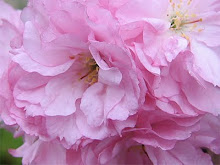
As I was doing a web search for "polenta," thinking that the term does not necessarily have to mean corn, I came across some interesting information about grains I've never heard of before.
Polenta evidently has been made from corn, chestnuts, semolina (using part of the wheat berry), farina (using another part of the wheat berry), and even crushed barley (which is where the Latin word, polenta, originated from). Polenta is a sort of "mush" or stiff "porridge" that holds its shape. When it's made from corn, you're getting the whole grain. I wonder if I could make a polenta with buckwheat groats? I don't think the groats are small enough for the right consistency, so I'd probably have to grind them up a little in my coffee grinder or flour mill first.
From reading about Polenta (according to wikipedia.org), my web search led me on to include various types of wheat berries:
Varieties of Wheat Berries
Durum — or Durum Wheat — The hardest of the winter wheats. Semolina flour from durum wheat is used for pasta—the yellow endosperm is what gives semolina its unique color.
Einkorn — or Einkorn Wheat — This type of "ancient" wheat is being revived and even has its own web site, einkorn.com!
Emmer — or Emmer Wheat, also known as farro or faro in Italy — This is another type of heirloom wheat that is being revived. You can get organic, whole-grain Emmer Farro on the Bluebird Grain Farms website.
Kamut — or Khorasan Wheat — has its own trademark and official website (kamut.com). You can buy organic kamut berries from Bob's Red Mill company, as well as other whole grains.
Red Wheat (hard, soft, winter, or spring wheat) — Here is a web page from Dr. Jim Beuerlein at Ohio State University that explains the different types of red, white, soft, hard, winter, and spring wheats grown in the United States: "Classes and Uses of Wheat."
Sorghum (wikipedia.org) — also, Sweet Sorghum — This small grain reminds me of amaranth in appearance, only larger. I'm familiar with sorghum syrup, or molasses, but I didn't know that the grain is eaten whole, mostly in other countries and especially in Africa. Here in the U.S., sorghum is used mainly for food or alcohol products and animal feed. According to the U.S. Grains Council, "Grain sorghum is the third most important cereal crop grown in the United States and the fifth most important cereal crop grown in the world." The council was established in 1960 to develop export markets for U.S. barley, corn, grain sorghum and related products. Purdue University has a Factsheet on grain sorghum, and there's more interesting info on the National Sorghum Growers website.
Spelt — also known as "dinkel" or "faro" or "farro" — Here is an article from "The New York Times" about the differences between spelt and farro: The Night Of The Big Spelt-Screw-Up
Triticale (hybrid of wheat and rye) — Here's an article about "what is triticale" in a food blog called "Chef In You, Making Vegetarian and Vegan Recipes Easy."
White Wheat (hard or soft winter wheat) — There is a Whole Grains Council that's dedicated entirely to whole grains and whole grain products. Here's what they have to say about white wheat: Whole White Wheat FAQ
There also is a website called the Wheat Foods Council that's dedicated entirely to wheat and wheat products (not necessarily whole grain products, however). In the FAQ section of their Grain Talk Blog, they talk about "What is Durum Wheat?" (September 2010), which is grown mostly in North Dakota because of the particular growing conditions required for this type of wheat.
Arrowhead Mills produces several whole grain products, including organic whole wheat berries.
As so there you have it — lots of information about grains!
Related Articles
• Whole Grains For Centering
• Whole Grains In Restaurants
• Lunch At P.F. Chang's






















































